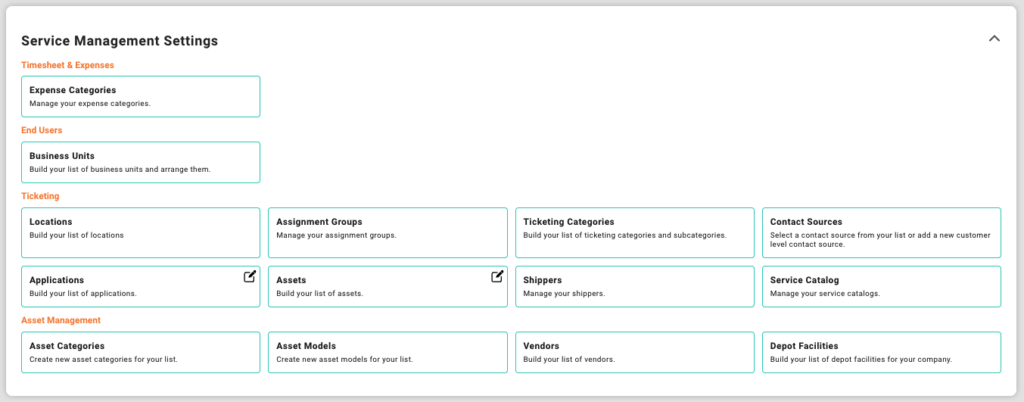On the Customer Detail screen, the last card is the Service Management Settings card. This card is used to configure all Service Management features (Ticketing, Asset Management, Change Management) for any Project for this customer. Although these Service Management features are set at the Project-level, you can configure them here at the Customer-level as well as the Global Settings menu so as to use these settings across multiple projects for this customer.

This card is extremely important for setting up projects that include the Expenses, Ticketing, Asset Management, or Change Management features of Startly.
Specific configuration features available on this card include:
- Expense Categories: define this Customer’s expense items and expense allowances.
- Business Units: define the internal Business Units for this customer, allowing you to create End Users and identify their internal organization at the customer.
- Locations: define the office locations for this customer. For service organizations who are providing onsite support for a customer, this feature allows you to monitor Tickets generated at a customer’s location and define specific response teams (called Assignment Groups) to quickly see and respond to an opened ticket at that location.
- Assignment Groups: create Service Management response teams at the Customer-level and add Team Members to these Assignment Groups. Examples of these service response teams may include “Level I Support Team”, “Asset Management Depot Team”, or “Stanford, CT Office” location-specific response team.
- Ticketing Categories: define specific ticketing categories (or groupings) to support reporting by Ticket Category to identify frequent issues or problems.
- Contact Sources: define the available methods for End Users to initiate tickets, such as Call, Email, Walk In, etc.
- Shippers: within the Asset Management module, define the list of available shipment methods, such as “UPS”, “FedEx”, USPS”, etc.
- Service Catalog: Tickets can be of 2 types: Incidents and Service Requests. A Service Request is an actionable request for service by the End User. You can define a list of available Service Requests within a Service Catalog.
- Custom List 1 and 2: similar to Ticketing Categories, provides for additional grouping or categorization of tickets for reporting purposes.
- Asset Category: also similar to Ticketing Categories, this feature allows you to group your Asset Management activities to allow for reporting on activities by category.
- Asset Models: define all model types being supported within Asset Management. This list may include entries like laptop models, computer monitor models for an IT services firm.
- Vendors: some service organizations provide service management support for their customers that includes support for other third-party applications and solutions. These third party “vendors” can be defined and referenced on tickets for workflow routing and reporting.
- Depot Facilities: a service organization may have multiple physical locations/facilities for providing Asset Management services. These facilities can be defined and referenced for asset management activities.
These Service Management Settings are critical to properly setting up and managing a project that includes Expenses, Ticketing, Asset Management, or Change Management features. To learn more about how best to use these features, check out our advanced article on Configuring a Service Management Project.